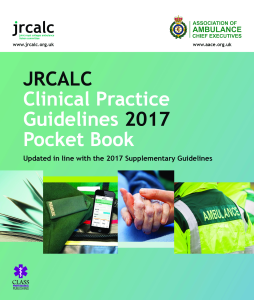
BOOK
JRCALC Clinical Practice Guidelines 2017 Pocket Book
(2017)
Additional Information
Book Details
Abstract
The JRCALC Clinical Practice Guidelines 2017 Pocket Book is up to date with both the 2016 guidelines and the 2017 supplementary guidelines. It includes the latest guidance on drug administration for diazepam, misoprostol, paracetamol, oxygen, naloxone hydrochloride and 0.9% sodium chloride. The Pocket Book is also up to date with best practice on pain management and spinal injury algorithms.
This quick reference tool provides reference and reassurance for all out of hospital clinicians.
Table of Contents
| Section Title | Page | Action | Price |
|---|---|---|---|
| Title | i | ||
| Disclaimer | ii | ||
| Contents | iv | ||
| RESUSCITATION | vi | ||
| Basic Life Support (Adult) | 2 | ||
| Advanced Life Support (Adult) | 2 | ||
| Airway and Breathing Management | 4 | ||
| Recognition of Life Extinct byAmbulance Clinicians | 6 | ||
| Action to be Taken afterVerification of Fact of Death | 6 | ||
| Implantable CardioverterDefibrillator | 8 | ||
| Foreign Body Airway Obstruction(Adult) | 8 | ||
| GENERAL | 10 | ||
| MEDICAL | 17 | ||
| Acute Coronary Syndrome | 18 | ||
| Adult Bradycardia Algorithm | 18 | ||
| Adult Tachycardia (With Pulse) | 20 | ||
| Heart Failure | 20 | ||
| Pulmonary Embolism | 22 | ||
| Asthma (Adults) | 22 | ||
| Asthma Peak Flow Charts | 24 | ||
| Chronic Obstructive PulmonaryDisease | 24 | ||
| Hyperventilation Syndrome | 26 | ||
| Convulsions (Adults) | 26 | ||
| Glycaemic Emergencies (Adults) | 28 | ||
| Allergic Reactions includingAnaphylaxis (Adults) | 28 | ||
| Sickle Cell Crisis | 30 | ||
| TRAUMA | 30 | ||
| Trauma – SCENE | 32 | ||
| Trauma – ATMIST | 32 | ||
| Trauma Survey | 34 | ||
| Trauma Emergencies Overview(Adults) | 34 | ||
| Intravascular Fluid Therapy(Adults) | 36 | ||
| Spinal Injury and Spinal Cord Injury | 38 | ||
| SPECIALSITUATIONS | 40 | ||
| methane Report Format | 42 | ||
| Triage Model | 42 | ||
| Chemical, Biological, Radiological,Nuclear and Explosive Incidents | 44 | ||
| PAEDIATRICS | 47 | ||
| Basic Life Support (Child) | 48 | ||
| Advanced Life Support (Child) | 48 | ||
| Newborn Life Support | 50 | ||
| Foreign Body Airway Obstruction(Child) | 50 | ||
| Death of a Child, including SuddenUnexpected Death in Infancy,Children and Adolescents (SUDICA) | 52 | ||
| The Wong-Baker FACES Pain RatingScale | 52 | ||
| The FLACC Scale | 54 | ||
| GREEN: NICE ‘Traffic Lights’Clinical Assessment Tool forFebrile Illness in Children | 55 | ||
| AMBER: NICE ‘Traffic Lights’Clinical Assessment Tool forFebrile Illness in Children | 56 | ||
| RED: NICE ‘Traffic Lights’Clinical Assessment Tool forFebrile Illness in Children | 56 | ||
| Modified Taussig Croup Score | 58 | ||
| Meningococcal Meningitis andSepticaemia | 58 | ||
| Allergic Reactions includingAnaphylaxis (Children) | 60 | ||
| Asthma (Children) | 60 | ||
| Peak Expiratory Flow Chart | 62 | ||
| Convulsions (Children) | 62 | ||
| Trauma Emergencies Overview(Children) | 64 | ||
| Intravascular Fluid Therapy(Children) | 66 | ||
| DRUGS | 69 | ||
| Adrenaline | 70 | ||
| Amiodarone | 72 | ||
| Aspirin | 74 | ||
| Atropine | 76 | ||
| Benzylpenicillin (Penicillin G) | 80 | ||
| Chlorphenamine | 82 | ||
| Clopidogrel | 84 | ||
| Dexamethasone | 88 | ||
| Diazepam | 90 | ||
| Entonox | 96 | ||
| Furosemide | 98 | ||
| Glucagon (Glucagen) | 100 | ||
| Glucose 40% Oral Gel | 106 | ||
| Glyceryl Trinitrate | 108 | ||
| Heparin | 110 | ||
| Hydrocortisone | 112 | ||
| Ibuprofen | 116 | ||
| Ipratropium Bromide | 118 | ||
| Metoclopramide | 122 | ||
| Midazolam | 124 | ||
| Patient’s Own Buccal | 128 | ||
| Misoprostol | 130 | ||
| Morphine Sulphate | 134 | ||
| Naloxone Hydrochloride | 140 | ||
| Ondansetron | 144 | ||
| Oxygen | 148 | ||
| Paracetamol | 162 | ||
| Reteplase | 174 | ||
| Salbutamol | 176 | ||
| 0.9% Sodium Chloride | 180 | ||
| Sodium Lactate Compound | 196 | ||
| Syntometrine | 209 | ||
| Tenecteplase | 210 | ||
| Tetracaine 4% | 214 | ||
| Tranexamic Acid | 218 | ||
| PAGE FOR AGE | 221 | ||
| BIRTH | 222 | ||
| 1month | 228 | ||
| 3months | 236 | ||
| 6months | 243 | ||
| 9months | 250 | ||
| 12months | 257 | ||
| 18months | 264 | ||
| 2YEARS | 270 | ||
| 3YEARS | 278 | ||
| 4YEARS | 286 | ||
| 5YEARS | 292 | ||
| 6YEARS | 300 | ||
| 7YEARS | 307 | ||
| 8YEARS | 314 | ||
| 9YEARS | 321 | ||
| 10YEARS | 328 | ||
| 11YEARS | 335 |
